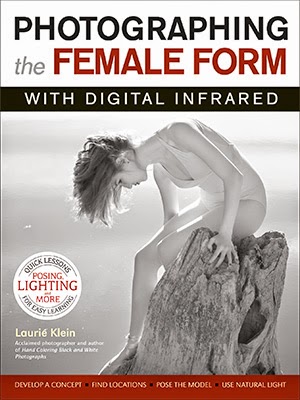
Near infrared light penetrates skin to a depth of a few millimetres. This tends to give skin a milky appearance as you're not seeing the surface (some moral there perhaps) but can also show up veins and make some marks, especially tattoos, stand out starkly. There can also be a spooky effect on eyes, making them look like dark pools. So combining infrared photography and skin can be 'interesting'.
Laurie Klein studied with Ansel Adams and spent some of her professional life as a landscape photographer, moving on to people and weddings. Her approach to people photography brings an appreciation of landscape; both the person in the landscape and the person as landscape. Almost all the images in the book are taken with a modified DSLR and shown in black and white. There is one example of 'good old' HIE 35mm film, which doesn't stand out as being that different from the digital shots, and one faux-colour shot ... of a woman in a wine-dark river ... which definitely benefits from the splash of colour. The models are all (or look to be) white; so my only wish would be to have seen what Laurie could do with darker skin tones. Having said that, the tonal differences at infrared wavelengths are not as pronounced as they are in visible light. In Laurie's photos, one interesting effect of the infrared is that the models' nipples render white as well. It's a very alabaster and sculptural look.
Incidentally I am impressed with the quality of the printing. In the past I have sometimes found Amherst's infrared images to be over-contrasty, but not here.
Alongside the photographs, Laurie explains how and why she posed the models as she did, and includes alternative 'takes' from the session. The train of thought is interesting, sometimes making me see the landscape photographer within being able to move those mountains to get the shot required. Here are nudes, props and landscape ... especially rocks and foliage ... arranged to taste.
As I said, it's a fascinating book, with lessons for all photographers and for any subject, and Laurie exploits the artistic possibilities of infrared light brilliantly.
[$27.95, 7.5x10 inches, 128 pages 180 photographs
ISBN-13: 978-1-60895-719-4]




